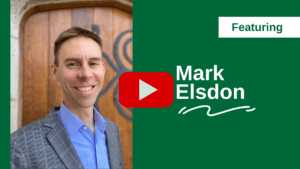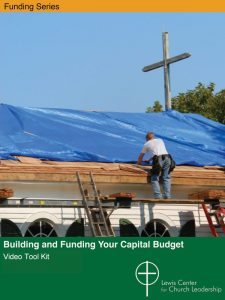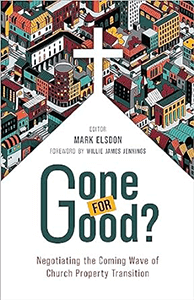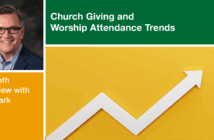
Is your church facing the difficult decision to sell or repurpose property? We speak with Mark Elsdon, editor of Gone for Good?, about how a congregation can pursue creative uses of church property in a way that avoids common pitfalls and propels their mission forward.
Listen on Apple Podcasts | YouTube Music | Spotify
Watch on YouTube

Read in-depth interview
- Transcript — Click or Tap to Read
-
Announcer: Leading Ideas Talks is brought to you by the Lewis Center for Leadership of Wesley Theological Seminary in Washington, DC. Subscribe free to our weekly e-newsletter, Leading Ideas, at churchleadership.com/leadingideas.
Your capital budget isn’t just about facilities — it’s about using your facilities to further your church’s mission. The Building and Funding Your Capital Budget Video Tool Kit shares best practices to help you understand what a capital budget is, how to engage the big questions about your church, and how to assess your current situation. No matter your church size, this resource provides clues and wisdom to help your capital budget advance your mission and accomplish God’s vision for your congregation. Learn more now at churchleadership.com/capitalbudget.
Is your church facing the difficult decision to sell or repurpose property? We speak with Mark Elsdon, editor of Gone for Good?, about how a congregation can pursue creative uses of church property in a way that avoids common pitfalls and propels their mission forward.
Ann Michel: Welcome to Leading Ideas Talks. I’m Ann Michel. I’m a senior consultant with the Lewis Center for Church Leadership of Wesley Theological Seminary. I’m also one of the editors of our e-newsletter Leading Ideas. I am so delighted to be the host of this episode of Leading Ideas Talks.
My guest today is Mark Elsdon, who’s an ordained minister in the Presbyterian Church, USA. He’s the author of two books on how churches and faith-based institutions can use their property assets for good. The first book came out in 2021, and it’s We Aren’t Broke: Uncovering Hidden Resources for Mission and Ministry. He has a new book released this year, Gone for Good? Negotiating the Coming Wave of Church Property Transactions. So, welcome to you, Mark.
Mark Elsdon: Good to be here.
Ann Michel: So, in reading your first book, or your earlier book I should say, We Aren’t Broke, I was somewhat surprised to learn that your entrée into this field of real estate transactions and how faith institutions can use their property creatively to carry their mission forward came when you were serving as a campus minister at the University of Wisconsin. Just to kind of bring our listeners into your world, can you very briefly share what you did in that context?
Mark Elsdon: I’m actually here right now in my office at the university, or at Pres House. I’ve been an executive director and was campus pastor for 20 years here at Pres House, the Presbyterian affiliated campus ministry center at the University of Wisconsin in Madison. My wife Erica Liu and I were called here together, and we came into a situation where the ministry was essentially empty, dead, sort of in a fallow period, you might say. It had a very storied hundred-year history, but at the moment we arrived, there were zero students involved and so we set about rebuilding the program and raising some money. To vastly simplify the story, we did in the end develop a $17 million, seven-story student housing facility that is home for about 240 students on the parking lot that was connected to the historic chapel building. Now this is a private entity, not university affiliated. But we’re right in the heart of the university.
Ann Michel: You hear of these things happening in churches, but your book was the first time I’d heard of something like this in a campus ministry setting. I thought it was so interesting that you got started in this way. To put this in a larger context, I think all of us who are following this area have seen projections of how many churches might close in the coming decades or how many other churches have property assets that no longer fit the current reality of their ministry. So, I wanted to ask you, how big do you think this phenomenon of church property transitions is likely to be?
Mark Elsdon: I think if the projections are even half what they’re saying — which is a hundred thousand churches or properties related to churches potentially closing or changing use in the next decade — if it’s even half that or even a quarter of that, it’s a huge number. It’s tens of thousands. It’s sort of inevitable when you look at the trajectory of involvement in church activity or at least traditional church activity, right? You know, the Pew study shows less than fifty percent, maybe even thirty percent, of Americans will affiliate with the Christian faith by 2070. That’s going to, of course, immediately ripple into the real estate that’s related to churches. I’d be happy if I’m wrong and if the others that are projecting this are wrong. But I think it’s going to be massive. I think it’s going to be a massive, massive sea change.
Ann Michel: You know, it seems to me that it’s not just a matter of declining attendance in churches. But it’s also that even in healthy and thriving churches, the nature of ministry is becoming less place based. I think about, in my own church, how many groups are now done on Zoom and how many staff are working from home for some part of the week. It’s just really changed the way churches use their property, even if they are in a healthy place.
Mark Elsdon: Yeah, and in fact, I always encourage healthy churches to think about this now because then they have the opportunity to actually do exciting, new things versus crisis management or closing management, which is important, too. But yeah, absolutely. I think in addition to what you’re describing, there are also just different ways of engaging the Christian faith. For many decades, it was quite traditional in the sense that people would come on Sunday morning for worship and then go down the hall for Sunday school and come for a
Wednesday meal or something midweek, you know. That kind of pattern has changed a great deal. Some of that’s gone online. Some of that’s gone remote. Some of it is just people who want to engage in a different way.
Ann Michel: More community engagement, too.
Mark Elsdon: Yeah, exactly.
Ann Michel: So, in high-priced urban real estate markets, like where I live in downtown Washington, D.C., a lot of churches, at least forward-thinking churches, have been engaged in creative redevelopment or creative use of their property for several decades. Gone for Good? is a compilation of chapters written by a very diverse group of church leaders, civic leaders, and real estate and planning professionals in a variety of different contexts. I think you probably have a better sense than I do of the opportunities and challenges in different areas of the country — rural, urban, suburban. How do you see the lay of that land broadly?
Mark Elsdon: I think broadly, first of all, this transition is happening across the entire nation and across denominations. There may be pockets of it that are different, and obviously any one individual church might be growing, thriving, or changing or not. But broadly speaking across denominations, across theological lines, and across geographic areas, the general trend is the same. I think that is just interesting to note.
I hear stories that are very similar in Washington, D.C., in Seattle, in San Francisco but also in rural Wisconsin, rural Texas, and rural Alabama. Everywhere. Literally everywhere. We might be slightly different in terms of timing or whatnot. What you note about the implications and the possibilities are a little bit different in an urban center where property values are very high or where the real estate is literally valuable financially and the needs might be of one nature. Then you end up with projects that kind of lend themselves to that situation. In a rural setting where those things might be very different — where a rural community has been in decline for a long time and property does not have the same sort of financial value, but a church still has a real important center to play in a community — it’s a different set of outcomes and uses of that property that you end up with.
Ann Michel: One of the chapters in the book addresses the ways that rural churches are using their properties to meet community needs. I found that chapter really, really interesting. Do you want to speak to that briefly?
Mark Elsdon: I found that super interesting, too. Because while I’m surrounded by rural settings, I’m not in one myself. I had a lot to learn from that and I continue to learn from people that are experimenting in that way. But that chapter highlights the importance, the centrality, of churches in rural settings and essentially invites that to continue in different forms, right? Some of the examples that I think are really interesting are churches near interstates that have been putting electric car charging stations in their parking lots.
Ann Michel: Well, it’s kind of like churches that were hosting cellphone towers.
Mark Elsdon: Yes, exactly. It’s in that same vein. Other churches have been doing healthcare partnerships with healthcare providers that might want to come into a community and maybe provide three hours of healthcare three days a week with a nurse practitioner. They don’t have the means or the need to build an entire standalone clinic, but they actually do need a set of areas to provide healthcare; and a church’s unused education wing could be perfect for that. It starts to rebuild that place as a center of gravity. Maybe a small farmer’s market pops up once a week. You kind of start from that and build a sense of community again around that space.
I’ve seen some more rural churches looking at doing small, senior housing — not huge ones but maybe a handful of units of senior housing to allow seniors in their community to stay and age in place rather than moving to the city. So, that’s another interesting idea, I think. As people get creative, they come up with really great ideas.
Ann Michel: There are some really wonderful success stories profiled in your book, like Emory Fellowship United Methodist Church here in Washington, D.C., that created 99 units of affordable housing on its church property. I wanted to ask you personally, is there a particular story or example of a church’s creative property redevelopment that you find most interesting or most inspiring?
Mark Elsdon: I love the story of Rev. Daniels’ church in Emory and Ashley Goff’s church in Arlington. Those stories of affordable housing are super, super exciting to me. One interesting example came up recently in the Portland area. A church that was closed recently was given to a coalition of indigenous leaders that are going to take that property and develop tiny homes on it to support women and children in the First Nations community there that are experiencing homelessness. To me that’s a beautiful act of property reuse. Also, it’s an act of restoration and recognition of that land and who lived on that land many, many years ago. It’s a beautiful act of just thinking differently about how to repurpose a church that had lived its life. Its property had lived its life, and it was time to think differently about it. To just hand it over in a generous way to some other leaders in the community to use it for real community needs, I think, is a particularly inspiring story.
Ann Michel: Thank you for sharing that. To follow up on this idea of some of the successful examples, I wanted to ask you, what are some of the common factors that underlie the success of churches that are able to make good decisions and navigate the often very unfamiliar and complicated terrain of selling or redeveloping property?
Mark Elsdon: My other organization, Rooted Good, works with churches through our Good Futures accelerator program as they’re trying to think about this stuff, come up with ideas, and test ideas. Probably the number one thing we see that is really, really critical is listening. Good, intentional, thoughtful listening to the community. To be totally frank, as a member of the church and as a clergy member, we often think we know more about what people need than we actually do. We often think, “Hey, let’s give them this. Let’s do this, it’s what everyone needs and wants.” We might be right but very often we’re not — or we’re not quite right.
There’s a lot of listening needed to understand what’s happening in a community, what the true needs are, what the true opportunities are, where God is already at work, and sort of coming alongside where God is already at work in the community. Definitely don’t read an article about my book or anyone else’s book that says to build affordable housing, and then go and build affordable housing. I love affordable housing, but don’t take something off the shelf and plop it into your setting. That does not work. In fact, that’s a recipe for not working. So, you really have to listen to what’s going on in the community and try to respond to that. It might be affordable housing, but it might not be. So, a listening posture is the number one thing that we’ve seen to be really important.
Ann Michel: Thank you. I think it’s true in so many areas of ministry and congregational revitalization that you can’t just copy what some other successful church has done. I think these issues related to church property are so highly contextual. I mean, it matters where you are, what the zoning is, what the property values are, and what your neighborhood is like. I may be overstating it, but I think it’s probably true that no two churches are alike in this regard.
Mark Elsdon: Yeah, I think that’s absolutely correct.
Your capital budget isn’t just about facilities — it’s about using your facilities to further your church’s mission. The Building and Funding Your Capital Budget Video Tool Kit shares best practices to help you understand what a capital budget is, how to engage the big questions about your church, and how to assess your current situation. No matter your church size, this resource provides clues and wisdom to help your capital budget advance your mission and accomplish God’s vision for your congregation. Learn more now at churchleadership.com/capitalbudget.
Ann Michel: You’ve probably already spoken to this, but I also wanted to ask about some of the pitfalls that need to be avoided as a church walks down this path.
Mark Elsdon: Yeah. There certainly are pitfalls. I’m always a little reticent to talk a lot about that because I think that most of us in mainline settings automatically jump to the pitfalls. My tendency is to try to encourage experimentation and trial and to not be afraid of failing because we might and in some ways we will fail or make mistakes if we do this work. That said, there are definitely some pitfalls. One related to real estate specifically is just being aware that there are a lot of other players involved that have a great deal at stake when it comes to a church real estate question — developers in the area, for example, who want to access property at low cost and want to make some money on it. Lots of churches, unfortunately, have been taken advantage of with regard to the value of their property.
I’m not at all for dollar maximization, and if you’ve read either of my books, you’ll get that sense. However, I’m also not a big fan of churches getting taken advantage of and having for-profit developers just swoop in and take their property at very low prices and then make a ton of money on it for themselves and privatize it. That does happen, unfortunately. So that’s a pitfall. I think it requires careful understanding of those dynamics and those relationships. Even cities as well, and other players in the mix, are going to have things at stake and the church is going to need to be aware of that. They may or may not align with their interests, and the church is going to have to hold out for its own interest a bit.
I think probably another major pitfall that we’re seeing is waiting too long. It’s amazing how often I have somebody reach out and say, “We’ve got 18 months left. What can we do? We need some help.” Eighteen months is not long enough, certainly not long enough, to do a really big development project. I mean, Rev. Daniels took 10 years at Emory Fellowship.
Ann Michel: I would say more! I witnessed it from the very beginning.
Mark Elsdon: Sure, at minimum. That was probably with at least 10 years prior to that of thinking about it. Ours was an 80-year thing. The first dream came around in 1927 and we opened in 2007. The “wait, wait, wait, wait, wait. Can we make it? Oh no, we can’t. Now we should talk about this,” is not very helpful. I’m not saying we’re going to take 80 years every time, but 18 years is not long enough. It’s much more productive and life giving to start that conversation earlier like you said at the beginning, even if you’re not thinking of closing but are just thinking more creatively about the use of property. The use of the buildings and the use of the land — how it can be used for ministry and mission, and maybe for revenue generation? Let’s think about that right now. Why wait? That would be the biggest other pitfall that we’re seeing a lot of. A bit of head in the sand, waiting, hoping, and then coming at the last minute and saying, “We need some help.” Well, you do your best in that scenario. But if you can start earlier, that’s very helpful.
Ann Michel: Related to this idea of how long it can take to do this successfully and thinking about this from a leadership perspective, I saw the amount of effort and time that it took Joe Daniels, for example, to do what he was able to accomplish. I think it takes an extraordinary amount of leadership capital and leadership expertise to do this successfully. I think it’s also probably safe to say that most of the clergy serving in our churches today don’t have extensive training in real estate transactions, community redevelopment, or affordable housing and the like. I teach in the areas of stewardship and finance, and I would go so far as to say that a lot of people entering ministry are struggling with just the basics of financial management. Congregations, too, as you’ve just said, often have a hard time facing their financial realities and embracing change. I guess my question is: how do congregations rally the leadership? Where does the leadership impetus come from, the vision, and the skills required to do this successfully?
Mark Elsdon: Yeah, I mean, that’s a great question. It is probably the question in many cases that leads to moving forward or not moving forward. I’m going to give three brief answers to that.
First, when we created our Good Futures accelerator at Rooted Good, we initially thought we were going to screen churches [to see]which ones were ready to do it or not ready to do it and which ones would be successful or not successful. If we had done that, we would have really messed up. Because COVID happened, we didn’t screen anyone, and we just let everyone try it. We were amazed by the churches that actually were successful. They were not always the ones we thought were necessarily going to be. In one case, a church in California that has very few members, very few leaders, and has had no pastor for years is doing an incredible affordable housing project. We would have thought, well, they weren’t going to be ready for that. But they were. Really it often just requires somebody or some bodies that are willing to work the process and just take the steps. To do the listening, to do the learning, to build the partnerships and the relationships and to go from there.
The second thing, I would say, is thinking much more broadly about who’s involved in these projects. We’re great in the church at taking it all on ourselves. You know, we (church members) shovel the snow in our area, we cut the grass. Especially if we’re in a tough spot financially that is the case. This is not going to work with social enterprise projects or development projects. You aren’t going to do it yourself. You won’t be signing leases with residents or maintaining a building that houses people. Even just a smaller social enterprise is going to require partnership, legal support, accounting, potentially other staff, and so on and so forth. Thinking much more broadly about who’s involved in this project (this is not just necessarily a project of the people in the church at this moment) is a great opportunity to extend the reach of the congregation and to involve other people. So, that’s the second thing. That partnership is key.
And then the third, I would say, theme we’ve been seeing is starting with something small. Not necessarily thinking we have got to do a 99-unit $60 million affordable housing project as the very first thing we do. That’s pretty daunting for a lot. I mean, I’d be daunted to do that even though I’ve done it before. It’s a huge undertaking but worth pursuing for sure. It’s like exercising. We don’t have to go to the gym for five hours on the first day to get back to exercising. Many of us in the church haven’t exercised some of these muscles around this kind of work for a very long time.
So, let’s just start with a little something first. And then get into it. If you’re interested in some kind of a new venture that involves social entrepreneurs or food entrepreneurs coming in and using a commercial kitchen to grow business and develop a partnership in the community, maybe just start with a food truck in your parking lot three Fridays in the summer. Pick three Fridays in the summer and invite a food truck to show up in your parking lot. That’s it. That’s the beginning. Begin to exercise that muscle around innovation and social enterprise. Learn what’s required from that little thing. Are there permits required? How do we account for it? Then move to the bigger project. Not diving all the way in immediately but starting small and then building some momentum and some excitement is a great way to get going. Those would be the responses I have initially to that to that question.
Ann Michel: Maybe you’ve already answered this question, but I wanted to ask about the very first steps a congregation that’s interested in assessing its options might take? You’ve already talked about listening, but are there some things that even precede that? Are there questions related to understanding your assets or the value of your building? What are some of their first steps?
Mark Elsdon: In the process we take churches through, we typically save questions of the building and the financial assets for a bit later [in the process]. We start more with the mission questions. In our sense, the practical questions can work themselves out if the mission questions are clear. So, yes, listening is probably at the beginning.
The other thing at the beginning that’s often helpful is thinking about where the church has done this before. In most cases they have done it before even if they feel like they haven’t. Maybe a church has never built affordable housing or a commercial kitchen venture before, but have they done something new, something innovative? Is there some legacy to build upon? Rarely do I see projects come completely out of the blue. They often have some tie to something that the congregation has done in the past or has talked about in the past. Like I said here, we had this idea 80 years ago of doing student housing and then we finally did it.
In the case of Emory Fellowship, Rev. Daniels is a great example too. They had a history of housing people and of addressing that issue that goes back centuries actually on that property. I’ve seen churches look at converting a beloved food pantry ministry into a community owned grocery co-op. They’re building on the legacy that they already have of something that they already know how to do. It kind of goes from there rather than just dragging something off the shelf, something that’s totally foreign to them, and trying to adopt that. Since the pandemic, you know, almost all congregations have pivoted and innovated in some way or another.
Ann Michel: Absolutely. I think congregations have shown how capable they are.
Mark Elsdon: Exactly. So, we actually start our accelerator — the very beginning of it is reflecting on what we have already done. What stories can we tell ourselves and remind ourselves about where we have innovated in the past? Where have we exercised that muscle in the past? How has that given us life? How has God shown up in that? That is a wonderful starting point. Then, move from there into listening in the community and into the following steps.
Ann Michel: Maybe I would say that it’s a matter of discerning your missional heart and working in alignment with what the missional heart of the congregation has been. I think that’s true in so many areas of ministry development.
So, to bring this to a close, you’ve already alluded to the fact that how churches use their property is not just a question of finances or maximizing the economic possibilities. It’s also a question of responsible stewardship. I appreciate that your book looks not just at the financial aspects of property transactions but also at some of the moral and theological considerations as well. To bring this to a close, can you speak to how a church can make sure that it remains faithful to its values and its beliefs in this process?
Mark Elsdon: Both of my books at the very core are really a call to reflect on our role as stewards of what we have been given. In my view, all of what we have been given — and this is true individually but certainly for congregations — is really a gift from God to make use of for the time that we have it. That’s true of our financial resources, our investments, our property. Particularly when we recognize where that property might have come from or where that money might have come from in the past.
We have this chance to steward those resources and to use those resources for the good of God’s work in the world. That’s fundamentally the question that I think is most important. The rest of the other questions flow from there, and they can get worked out from there. Returning to the core each time is really important in my view and is what in some ways separates the church from any other entity as well, that we are driven by that. There is something bigger than us, bigger than this congregation, this congregation’s building, and this congregation’s land. We are a part of a much bigger story. I’m not just talking about a denomination, but I’m talking about the whole story of God’s people, right? That to me is really vital and life giving as well and is a hopeful place to start.
Ann Michel: Again, your book is Gone for Good? Negotiating the Coming Wave of Church Property Transitions. It took me a while, as I was reading the book, to realize that “gone for good” is kind of a play on words. On the one hand, your church property might be “gone for good” — permanently — in terms of your property. On the other hand, it can be gone for the greater “good.” That’s the kind of framework that you bring to this. Thank you so much for these really important books that are helping people understand the possibilities of this. And thank you for your enthusiasm and your work in this area. It’s been great talking to you today, Mark.
Mark Elsdon: It’s been a pleasure. Thank you.
Don’t forget to subscribe to our free weekly e-newsletter, Leading Ideas, to be notified when new episodes are published. Visit churchleadership.com/leadingideas.
Gone for Good?: Negotiating the Coming Wave of Church Property Transition, Mark Elsdon, editor (Wm. B. Eerdmans, 2024), available at Wm. B. Eerdmans Publishing Co., Cokesbury, and Amazon.
Related Resources
- 7 Dos and Don’ts When Considering the Redevelopment of Church Property by Rick Reinhard
- Funding Forward: Developing New Revenue Sources for Your Congregation featuring Grace Pomroy — Leading Ideas Talks podcast episode | Podcast video | In-depth interview
- Should Your Church Consider Selling Property? by Domenic Dutra
- Building and Funding Your Capital Budget, a Lewis Center video tool kit resource
Photo by Juliana Chyzhova on Unsplash






